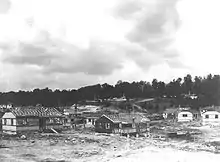Cemesto
Cemesto is a sturdy, light-weight, waterproof and fire-resistant composite building material made from a core of sugar cane fiber insulating board surfaced on both sides with asbestos and cement.[1][2] Its name is a portmanteau word combining "cem" from "cement" and "esto" from "asbestos." A type of prefabricated home using this material came to be called cemestos.

Cemesto was introduced by the Celotex Company in 1937.[1] It was manufactured in the form of boards and panels that were 4 feet (1.2 m) wide, about 1.5 inches (3.8 cm) thick,[3] and 4 feet (1.2 m) to 12 feet (3.7 m) long.[4] Each 4 feet (1.2 m) by 12 feet (3.7 m) panel weighs just 265 pounds (120 kg).[2] Cemesto was used primarily for interior and exterior walls.
The John B. Pierce Foundation and Celotex collaborated to develop a prefabrication system for building low-cost housing using cemesto panels, in which single cemesto panels were slid horizontally into light wooden frames to create walls.[2][5] A prototype cemesto house was displayed at the 1939 World's Fair in New York City.[6] The Pierce system was first used in 1941 for building employee housing at the Glenn L. Martin Aircraft Company near Baltimore, Maryland.[5][7] For this development, named Aero Acres, the architecture firm of Skidmore, Owings & Merrill designed gable-roofed Cape Cod houses with dimensions of 24 feet (7.3 m) by 28 feet (8.5 m), featuring large commercial-style windows in their principal rooms. In 1941 a total of 600 homes were built at Aero Acres using this design.[2]
During World War II, when other building materials were in short supply, cemesto was used extensively in the United States.[4][5] Cemesto was used to build temporary office buildings in Washington, D.C.[8] Skidmore, Owings, and Merrill adapted the Pierce system and used cemesto panels for the designs of some 2,500 pre-fabricated homes, known by the nickname "cemestos," erected in Oak Ridge, Tennessee, to house Manhattan Project workers and their families.[9] In 1942 the U.S. Farm Security Administration built 400 cemesto homes in Maryland at a site alongside Aero Acres.[2]
During the 1940s, the manufacturer of cemesto touted it as a material that would in the future make it possible to mass-produce housing at a low cost.[3] One use of the material during the post-war era was in the late 1940s in Circle Pines, Minnesota, where cemesto panels were used in building the first homes in what was envisioned to be a cooperative housing community for people of color.[10] The use of cemesto in Circle Pines came to be regarded as substandard construction, as the builders failed to adequately seal the joints between cemesto panels.[10]
Several prominent architects embraced cemesto as a modern material and used it in their designs. For the Bousquet-Wightman House in Houston, Texas, built in 1941, architect Donald Barthelme used cemesto panels for exterior sheathing.[11] In 1949 Edward Durell Stone called for cemesto panels in the design of a home to be built in Armonk, New York.[12] That same year, Charles Eames designed his Eames House, Case Study House #8, to use brightly painted and unfinished Cemesto panels in a prefabricated steel frame. [13] Frank Lloyd Wright designed the Raymond Carlson House in Phoenix, Arizona, built in 1950, to use a structural system of wood posts and cemesto boards.[4][14] In the Arthur Pieper House in Paradise Valley, Arizona, built in 1952 from concrete block, Wright used cemesto for the ceilings.[15]
In addition to houses and office buildings, cemesto was used to build gasoline stations and factories.[1]
References
- Material Name: Celotex, Boston Museum of Fine Arts, CAMEO website, accessed January 5, 2014
- Jack Breihan, Glenn L. Martin Aircraft Company Archived 2011-07-21 at the Wayback Machine, DOCONews, Summer 2008, page 7, DOCOMOMO US (the U.S. working party for DOcumentation and COnservation of buildings, sites and neighborhoods of the MOdern MOvement)
- The Cemesto Future, Time magazine, May 31, 1943
- Frank Lloyd Wright, Around AZ website, accessed October 24, 2008
- House and Yard: The Design of the Suburban Home, in Historic Residential Suburbs: Guidelines for Evaluation and Documentation for the National Register of Historic Places, by David L. Ames and Linda Flint McClelland, 2002
- Robert Hugh Kargon and Arthur P. Molella, Invented Edens: Techno-Cities of the Twentieth Century, MIT Press, 2008, ISBN 0-262-11320-1, ISBN 978-0-262-11320-5 pages 76–77
- The General Panel Corporation; Dream and Reality: America in War and Peace, pages 279-284 Archived November 21, 2008, at the Wayback Machine. Retrieved from Lustron Preservation website, April 15, 2011.
- Antoinette Josephine Lee, Architects to the Nation: The Rise and Decline of the Supervising Architect's Office, 2000, Oxford University Press US, ISBN 0-19-512822-2, ISBN 978-0-19-512822-2, page 283
- National Register of Historic Places Registration Form for Oak Ridge Historic District Archived 2010-08-29 at the Wayback Machine, July 18, 1991
- Christy DeSmith, A People’s History of Circle Pines, The Rake, November 2006
- HOUSTON MOD AND THE UNIVERSITY OF HOUSTON SCHOOL OF ARCHITECTURE HOST THE BARTHELME EXHIBITION, Houston Mod website, accessed October 24, 2008
- Index to Edward Durell Stone Papers, University of Arkansas Libraries, accessed October 24, 2008
- Case Study House For 1949 Arts & Architecture magazine, Dec 1949
- William Allin Storrer, The Architecture of Frank Lloyd Wright, A Complete Catalog, 2002, The University of Chicago Press, ISBN 0-226-77622-0, ISBN 978-0-226-77622-4, pages 329–330
- William Allin Storrer, The Architecture of Frank Lloyd Wright, A Complete Catalog, 2002, The University of Chicago Press, ISBN 0-226-77622-0, ISBN 978-0-226-77622-4, pages 352–353